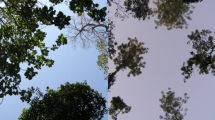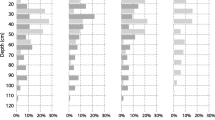Abstract
In suboptimal conditions for coffee growth, the use of shade tree is usually considered beneficial to production. This study aimed to evaluate this benefit in the poorly documented East African smallholder Arabica coffee systems in optimal climatic but suboptimal management conditions. In a 4 year observational trial in 50 coffee farms, the association of shade trees and coffee generated an average 55 % cherry production increase. Neither delay in berry maturation nor buffer in alternate bearing patterns were observed, probably due to the low productivity of unfertilized coffee plants. Quality wise, the presence of shade trees did not result in an increase of larger green beans, but it reduced the proportion of altered and lighter cherries in 2009, a low production year. A shade species effect was detected through the positive influence of two non-leguminous shade trees, Persea americana and Ficus thonningii on production. The effect was correlated to greater canopy openness and increase in K soil content. In general, soil mineral content was not influenced by the presence of trees, but the legume species Inga oerstediana appeared responsible for a slight increase of total C and N soil content. It is concluded that in the small holder context of the Northern Lake Kivu region, the association of mature trees is beneficial to coffee production and can contribute to the improvement of producer’s income.




Similar content being viewed by others
References
Abruňa F, Vicente-Chandler J, Silva S, Gracia W (1965) Productivity of nine coffee varieties growing under intensive management in full sunlight and partial shade in the coffee region of puerto rico. J Agric Univ Puerto Rico 49(2):244–253
Barradas VL, Fanjul L (1986) Microclimatic characterization of shaded and open-grown coffee (C. arabica L.) plantations in Mexico. Agric For Meteor 38:101–112
Beer J (1987) Advantages, disadvantages and desirable characteristics of shade trees for coffee, cacao and tea. Agrofor Syst 5:3–13
Beer J, Muschler R, Kass D, Somarriba E (1998) Shade management in coffee and cacao plantations. Agrofor Syst 38:139–164
Bertrand B, Vaast P, Alpizar E, Etienne H, Davrieux F, Charmettant P (2006) Comparison of bean biochemical composition and beverage quality of arabica hybrids involving sudanese-ethiopian origins with traditional varieties at various elevations in Central America. Tree Physiol 26:1239–1248
Boyer J (1968) Influence de l’ombrage artificiel sur la croissance végétative, la floraison et la fructification des caféiers robusta. Café Cacao Thé XII(4):302–319
Cannell MGR (1976) Crop physiology of coffee bean yield—a review. Kenya coffee 41:245–253
Cannell MGR (1985) Physiology of coffee crop. In: Clifford MN, Willson KC (eds) Coffee botany, biochemistry and production of bean beverage. Croom Helm, London, pp 108–134
Cavatte PC, Oliveira AAG, Morais LE, Martins SCV, Sanglard LMVP, DaMatta FM (2012) Could shading reduce the negative impacts of drought on coffee? A morphological analysis. Physiol Plant 144:111–122
Coste R (1955) Les caféiers et les cafés dans le monde. I- Les caféiers, Larose, Paris
DaMatta F (2004) Ecophysiological constraints on the production of shaded and unshaded coffee—a review. Field Crops Res 86:99–114
De Souza HN, De Goede RGM, Brussaard L, Cardoso IM, Duarte EMG, Fernandes RBA, Gomes LC, Pulleman MP (2012) Protective shade, tree diversity and soil properties in agroforestry systems in the Atlantic rainforest biome. Agric Ecosyst Environ 146:179–196
Descroix F, Snoeck J (2004) Environmental factors suitable for coffee cultivation. In: Wintgens JN (ed) Coffee: growing, processing, sustainable production. Wiley-Vch Verlag GmbH & Co. KGaA, Weinheim, pp 164–177
GLA—Gap Light Analyzer (1999) Simon Fraser University, Institute of Ecosystem Studies. http://www.caryinstitute.org/science-program/our-scientists/dr-charles-d-canham/gap-light-analyzer-gla. Accessed Oct 2012
Guiscafre-Arrillada J (1957) Sombra o sol para el cafeto? El Café de El Salv 308(9):320–364
Guyot B, Petnga E, Vincent JC (1988) Analyse qualitative d’un café Coffea canephora var Robusta en fonction de la maturité. I. Evolution des caractéristiques physiques, chimiques et organoleptiques. Café Cacao Thé 32:127–140
Guyot B, Manez JC, Perriot JJ, Giron J, Villain L (1996) Influence de l’altitude et de l’ombrage sur la qualité des cafés arabica. Plant rech dév 3:272–280
Hagar J, Barrios M et al (2011) Coffee agroecosystem performance under full sun, shade, conventional and organic management regimes in Central America. Agrofor Syst 82(285):301
ICO (2012). http://www.ico.org/trade_e.asp?section=About_Coffee. Accessed Oct 2012
Jagoret P and Descroix F (2002) Changes in Coffea canephora cultivation in Africa, and development issues. Evolution de la culture de Coffea canephora en Afrique et problématique de développement. Plantation Recherche développement 44–53
Jose S (2009) Agroforestry for ecosystem services and environmental benefits: an overview. Agrofor Syst 76:1–10
Kumar D, Tieszen JL (1980) Photosynthesis in Coffea arabica I. Effects of light and temperature. Exp Agric 16:13–19
Mehlich A (1984) Mehlich 3 soil test extractant: a modification of the Mehlich 2 extractant. Commun Soil Sci Plant Anal 15(12):1409–1416
Michel L (1943) Pratique de la culture du cafeier arabica par les indignes du Ruanda Nord. Bulletin Agricole du Congo Belge xxxiv(1–4):109–121
Ministere de l’Agriculture de l’Elevage et des Forets (MINAGRI) (1988) Carte pédologique du Rwanda (CPR), feuille 7 et feuille 14. BP 621, Kigali, Rwanda
Ministry of Agriculture and Animal Resources (MINAGRI) and Ministry of Trade and Industry (MINICOM) (2008) Rwanda National Coffee Strategy 2009–2012. Ministry of Agriculture and Animal Resources, Ministry of Trade and Industry, Government of the Republic of Rwanda, Kigali, Rwanda
Mouen Bedimo JA, Dufour BP, Cilas C, Avelino J (2012) Effets des arbres d’ombrage sur les bioagresseurs de coffea arabica. Cah Agric 21:89–97. doi:10.1684/agr.2012.0550
Muschler RG (2001) Shade improves coffee quality in a sub-optimal coffee zone of Costa Rica. Agrofor Syst 51:131–139
Nair PKR (1980) Agro forestry species a crop sheets manual. ICRAF, Nairobi
OCIR CAFÉ (2009) National coffee census—final report. Rwanda Coffee Development Authority
Pinard F (2007) Sur les chemins des caféiers. Etudes rurales 180:17–34
Planard A, Paquay R (1961) Quelques observations sur la culture du caféier d’arabie au rwanda-burundi. Bull Agricole du Congo LII(1):9–36
Purseglove JW (1968) Tropical crops: dicotyledons. Longman, Harlow 719p
R Core Team (2013) R: a language and environment for statistical computing. R Foundation for Statistical Computing, Vienna, Austria. http://www.R-project.org/
REMA (2009) Rwanda state of environment and outlook 2009. Rwanda Environment Management Authority (REMA), Kigali, Rwanda
Schroth G, Sinclair FL (eds) (2003) Trees, crops and soil fertility. Concepts and research methods. CAB International, Wallingford
Siegel S, Castellan NJ (1988) Non-parametric statistics for the behavioural sciences. McGraw Hill Int, New York, pp 213–214
Snoeck J (1959) Le caféier d’Arabie à Rubona. Bull d’Information de l’INEAC viii(2):69–99
Snoeck J, Petit R (1961) L’amélioration des méthodes culturales du caféier d’Arabie à Mulungu. Bull d’Information de l’INEAC X(1):53–68
Staver C, Guharay F, Monterroso D, Muschler RG (2001) Designing pest-suppressive multistrata perennial crop systems: shade-grown coffee in Central America. Agrofor Syst 53:151–170
Vaast P, Dauzat J, Génard M (2002) Modeling the effect of fruit load, shade and plant water status on coffee berry growth and carbon partitioning at the branch level. Acta Hortic (ISHS) 584:57–62
Vaast P, Bertrand B, Perriot JJ, Guyot B, Genard M (2006) Fruit thinning and shade improve bean characteristics and beverage quality of coffee (Coffea arabica L.) under optimal conditions. J Sci Food Agric 86:197–204
Vaast P, van Kanten R, Siles P, Angrand J, Aguilar A (2007) Biophysical interactions between timber trees and Arabica coffee in suboptimal conditions of Central America. In: Jose S, Gordon AM (eds) Towards agroforestry design: an ecological approach. Springer, New York, pp 135–148
Van Kanten R, Vaast P (2005) Transpiration of Arabica coffee and associated shade tree species in sub-optimal, low-altitude conditions of Costa Rica. Agrofor Syst 81:187–202
Vicente-Chandler J, Abruna F, Bosque-Lugo R, Silva S (1968) Intensive coffee culture in Puerto Rico. Agric Exp Stat Univ Puerto Rico, Bull 211:6–16
Willey RW (1975) The use of shade in coffee, cocoa and tea. Commonwealth Bur Hortic Plant Crops Hortic Abstr 45(12):791–798
Acknowledgments
The assistance of Jean-Claude Bambe from ISAR (Institut Supérieur d’Agronomie du Rwanda) for species indentification as well as that of Martin Nguendo, David Kagoro, Elidad Uwiringiyimana, and Theonest Nsabimana for field implementation is gratefully acknowledged. This study was initiated by the project ‘Shade Tree Agroforestry in Lake Kivu’ funded by ACDI-VOCA under USAID Cooperative agreement FPP-A-00-04-00073 and was further extended with support from the project ‘Connecting, enhancing and sustaining environmental services and market values of coffee agroforestry in Central America, East Africa and India’ (CAFNET) financed by European Commission, Program on Environment in Developing Countries.
Author information
Authors and Affiliations
Corresponding author
Rights and permissions
About this article
Cite this article
Pinard, F., Boffa, J.M. & Rwakagara, E. Scattered shade trees improve low-input smallholder Arabica coffee productivity in the Northern Lake Kivu region of Rwanda. Agroforest Syst 88, 707–718 (2014). https://doi.org/10.1007/s10457-014-9712-7
Received:
Accepted:
Published:
Issue Date:
DOI: https://doi.org/10.1007/s10457-014-9712-7




